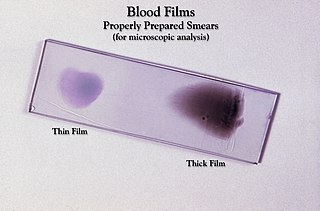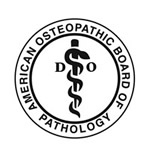Related Research Articles

Pathology is the study of disease and injury. The word pathology also refers to the study of disease in general, incorporating a wide range of biology research fields and medical practices. However, when used in the context of modern medical treatment, the term is often used in a narrower fashion to refer to processes and tests that fall within the contemporary medical field of "general pathology", an area that includes a number of distinct but inter-related medical specialties that diagnose disease, mostly through analysis of tissue and human cell samples. Idiomatically, "a pathology" may also refer to the predicted or actual progression of particular diseases, and the affix pathy is sometimes used to indicate a state of disease in cases of both physical ailment and psychological conditions. A physician practicing pathology is called a pathologist.

Anatomical pathology (Commonwealth) or anatomic pathology (U.S.) is a medical specialty that is concerned with the diagnosis of disease based on the macroscopic, microscopic, biochemical, immunologic and molecular examination of organs and tissues. Over the 20th century, surgical pathology has evolved tremendously: from historical examination of whole bodies (autopsy) to a more modernized practice, centered on the diagnosis and prognosis of cancer to guide treatment decision-making in oncology. Its modern founder was the Italian scientist Giovan Battista Morgagni from Forlì.

Forensic pathology is pathology that focuses on determining the cause of death by examining a corpse. A post mortem examination is performed by a medical examiner or forensic pathologist, usually during the investigation of criminal law cases and civil law cases in some jurisdictions. Coroners and medical examiners are also frequently asked to confirm the identity of remains.
Dermatology is the branch of medicine dealing with the skin. It is a speciality with both medical and surgical aspects. A dermatologist is a specialist medical doctor who manages diseases related to skin, hair, nails, and some cosmetic problems.
Internal medicine, also known as general internal medicine in Commonwealth nations, is a medical specialty for medical doctors focused on the prevention, diagnosis, and treatment of internal diseases in adults. Medical practitioners of internal medicine are referred to as internists, or physicians in Commonwealth nations. Internists possess specialized skills in managing patients with undifferentiated or multi-system disease processes. They provide care to both hospitalized (inpatient) and ambulatory (outpatient) patients and often contribute significantly to teaching and research. Internists are qualified physicians who have undergone postgraduate training in internal medicine, and should not be confused with "interns”, a term commonly used for a medical doctor who has obtained a medical degree but does not yet have a license to practice medicine unsupervised.

The Royal College of Physicians and Surgeons of Canada is a regulatory college which acts as a national, nonprofit organization established in 1929 by a special Act of Parliament to oversee the medical education of specialists in Canada.

Clinical pathology is a medical specialty that is concerned with the diagnosis of disease based on the laboratory analysis of bodily fluids, such as blood, urine, and tissue homogenates or extracts using the tools of chemistry, microbiology, hematology, molecular pathology, and Immunohaematology. This specialty requires a medical residency.
Established in 1933, the American Board of Medical Specialties (ABMS) is a non-profit organization which represent 24 broad areas of specialty medicine. ABMS is the largest and most widely recognized physician-led specialty certification organization in the United States. The other certification organizations in the United States are the American Board of Physician Specialties and American Osteopathic Association Bureau of Osteopathic Specialists.
Addiction medicine is a medical subspecialty that deals with the diagnosis, prevention, evaluation, treatment, and recovery of persons with addiction, of those with substance-related and addictive disorders, and of people who show unhealthy use of substances including alcohol, nicotine, prescription medicine and other illicit and licit drugs. The medical subspecialty often crosses over into other areas, since various aspects of addiction fall within the fields of public health, psychology, social work, mental health counseling, psychiatry, and internal medicine, among others. Incorporated within the specialty are the processes of detoxification, rehabilitation, harm reduction, abstinence-based treatment, individual and group therapies, oversight of halfway houses, treatment of withdrawal-related symptoms, acute intervention, and long term therapies designed to reduce likelihood of relapse. Some specialists, primarily those who also have expertise in family medicine or internal medicine, also provide treatment for disease states commonly associated with substance use, such as hepatitis and HIV infection.
The American Board of Internal Medicine (ABIM) is a 501(c)(3) nonprofit, self-appointed physician-evaluation organization that certifies physicians practicing internal medicine and its subspecialties. The American Board of Internal Medicine is not a membership society, educational institution, or licensing body.

Surgical pathology is the most significant and time-consuming area of practice for most anatomical pathologists. Surgical pathology involves gross and microscopic examination of surgical specimens, as well as biopsies submitted by surgeons and non-surgeons such as general internists, medical subspecialists, dermatologists, and interventional radiologists.
Gastrointestinal pathology is the subspecialty of surgical pathology which deals with the diagnosis and characterization of neoplastic and non-neoplastic diseases of the digestive tract and accessory organs, such as the pancreas and liver.
The American Board of Family Medicine (ABFM) is a non-profit, independent medical association of American physicians who practice in family medicine and its sub-specialties. Founded in February 1969 as the American Board of Family Practice (ABFP), the group was the 20th medical specialty to be recognized by the American Board of Medical Specialties and was formed out of a need to encourage medical school graduates to enter general practice. It adopted its current name in 2005.
Maintenance of Certification (MOC) is a recently implemented and controversial process of physician certification maintenance through one of the 24 approved medical specialty boards of the American Board of Medical Specialties (ABMS) and the 18 approved medical specialty boards of the American Osteopathic Association (AOA). The MOC process is controversial within the medical community, with proponents claiming that it is a voluntary program that improves physician knowledge and demonstrates a commitment to lifelong learning. Critics claim that MOC is an expensive, burdensome, involuntary and clinically irrelevant process that has been created primarily as a money-making scheme for the ABMS and the AOA.
Board certification is the process by which a physician or other professional demonstrates a mastery of advanced knowledge and skills through written, oral, practical, or simulator-based testing.
The College of American Pathologists (CAP) is a member-based physician organization founded in 1946 comprising approximately 18,000 board-certified pathologists. It serves patients, pathologists, and the public by fostering and advocating best practices in pathology and laboratory medicine.
The American Board of Nuclear Medicine (ABNM) certifies physicians as specialists in the practice of nuclear medicine. Diplomates of the ABNM are called nuclear medicine physicians. The ABNM is one of the 24 member boards of the American Board of Medical Specialties (ABMS).
The American Board of Dermatology (ABD), located in Newton, Massachusetts, United States, certifies physicians in dermatology, dermatopathology, and pediatric dermatology. Board-certified physicians are known as diplomates. Since its inception in 1932, the ABD has certified over 15,000 physicians. The ABD was one of the original four sponsoring organizations of the American Board of Medical Specialties (ABMS). Dermatologists possess expertise in all aspects of healthy and diseased skin through basic scientific research and clinical care. In addition to the wide range of medical diseases, dermatologists have practices devoted to skin surgery, care of children with skin disease, immunologic diseases of the skin and pathology of the skin. Dermatologists play an important role in the maintenance of the general public health in educating people about sun avoidance, sun protection and the signs of skin cancer.

The American Osteopathic Board of Pathology (AOBPa) is an organization that provides board certification to qualified Doctors of Osteopathic Medicine (D.O.) who specialize in the diagnosis and characterization of disease in patients following thorough examination of biopsies and/or bodily fluids (pathologists).
The American Board of Obstetrics and Gynecology is a non-profit organization that provides board certification for practicing obstetricians and gynecologists in the United States and Canada. It was founded in 1927, incorporated in 1930, and is based in Dallas, Texas. It is one of 24 medical boards recognized by the American Board of Medical Specialties. ABOG's mission is to define the standards, certify obstetricians and gynecologists, and facilitate continuous learning to advance knowledge, practice, and professionalism in women's health.
References
- ↑ "Board Certification and Maintenance of Certification | ABMS". www.abms.org. Retrieved December 1, 2017.
- 1 2 "American Board of Pathology". www.abpath.org. Archived from the original on December 2, 2017. Retrieved November 29, 2017.
- 1 2 3 "ABPath BOOKLET OF INFORMATION" (PDF). www.abpath.org.
- 1 2 3 "Steps Toward Initial Certification and MOC | American Board of Medical Specialties". www.abms.org. Retrieved December 1, 2017.
- ↑ "Primary Examinations". The American Board Of Pathology. Retrieved 2020-04-05.